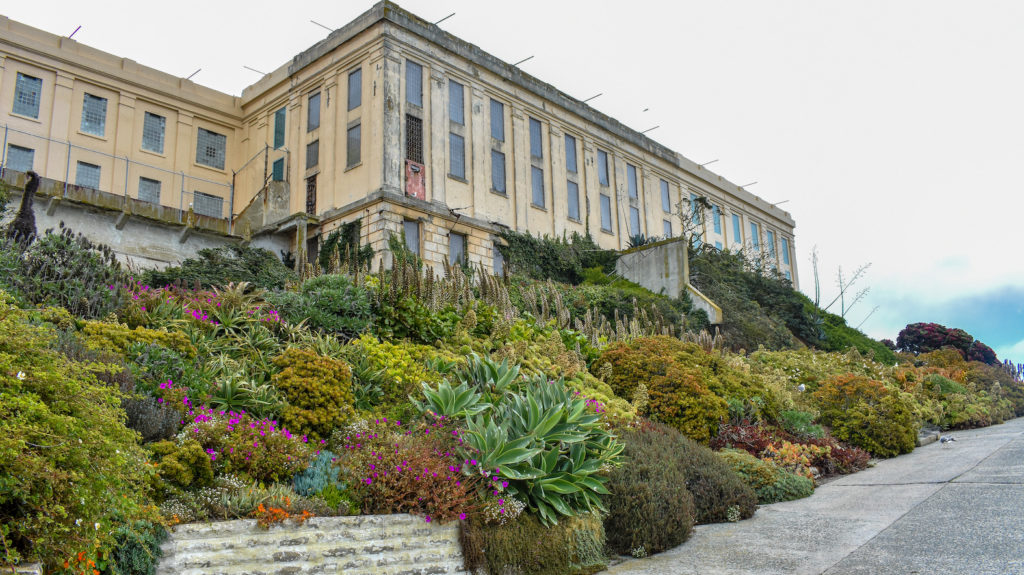Everyone’s heard of “The Rock:” the infamous maximum-security prison that operated from 1934 to 1963 on a tiny, harsh, rugged island in San Francisco Bay: Alcatraz.
The Rock has spawned movies, books, and folk heroes: “Escape from Alcatraz;” the “Birdman of Alcatraz,” Robert Stroud. Al Capone was incarcerated here, as were such notorious criminals as George “Machine Gun” Kelly, Alvin “Creepy” Karpis, Roy Gardner, and Frank Lee Morris.
But the rich and varied history of Alcatraz extends far beyond its site as a penitentiary. It was used in the 1850s as a military fort. Its lighthouse, still in operation today, was the first on the West Coast. In 1969 Indigenous activists occupied Alcatraz for 19 months. They hung a portrait of Geronimo over the fireplace mantel in the old Penitentiary Warden’s mansion and held tribal meetings around the hearth.
Today it’s known as an important bird-nesting locale as well as for the historic Alcatraz Gardens.
The Alcatraz facilities are now managed by the National Park Service as part of Golden Gate National Recreation Area. The round-trip ferry ticket for the 1.25-mile ride will set you back $45.25, but that includes any number of tours, including a general orientation tour of the island, a self-guided walking tour of the prison and, depending on the day, bird-watching tours and garden tours. There’s also a Night Cruise ($56.30) and a Behind the Scenes Tour ($101.30).
Major stop-off points include the Dock, the Barracks Apartments, the Guardhouse and Sally Port, the Post Exchange and Officers’ Club, the Military Schoolhouse, the Cellhouse, the Lighthouse and the Warden’s Mansion.
Completely apart from the history, you could spend hours simply drinking in the beauty of the island, the old moss-covered buildings, the beautifully landscaped winding walkways, the 360-degree views, the sea air, the flowers, and the birds.
Birds nesting on the island include three species of cormorant, the Black-crowned Night-Heron and the Snowy Egret. Everywhere you look, a lone Western Seagull has staked out a spot among the ice plant, or in a rock crevice, or atop a ledge, and sits serenely gazing out at nothing in particular.
My friend and I observed one such gull who had apparently decided to build a nest beneath a stone bench overlooking the bay. She (or possibly he: both sexes gather material, build the nest, and incubate the eggs) leisurely ambled across a paved area and deposited a mouthful of grass and twigs onto a growing pile, then settled down on top for a few seconds, scooching this way and that, the way you or I might test a mattress for softness. Nah, needs more, the bird decided, and wandered back into the underbrush for more supplies.
The prison is predictably grim, especially the isolation block and The Hole. Some of the more desperate inmates leaned psychopath, but many others were caught in a brutal system that was designed to break the prisoner, not to reform or rehabilitate him. Convicted murderer Stroud, by some accounts a genius, had been allowed to keep and study birds at Leavenworth, but was forbidden to do so during his 17 years of incarceration at The Rock — much of it in solitary confinement — making his nickname “The Birdman of Alcatraz” a major misnomer.
Good-behavior inmates could check books out of the prison library, subscribe to magazines, and listen to the radio. Many played bridge or chess. For 2 1/2 hours each day, the men had access to the rec yard. But the wind coming off the bay made for fierce cold, and in its heyday, Alcatraz — housing as it did “problem” prisoners, serial killers, and crime syndicate kingpins — was by all accounts one of the harshest maximum-security prisons in the U.S. Thirty-six prisoners tried 14 separate escapes, none verified as successful.

The Bardou Job Rose. (Wikimedia Commons)
The gardens are spectacular. Officers’ families and staff began digging borders and planting terraces even before the maximum-security prisoners arrived. Images taken as far back as 1870 show a formal Victorian garden in resplendent bloom. When the Bureau of Prisons arrived in 1933, Fred Reichel, the warden’s secretary, began caring for the gardens himself, collecting plants from around the world and training certain inmates.
One, Elliott Michener, wrote to the warden after his release, “For the first time I’m learning how much better one can do living honestly than by, say, counterfeiting! We have cars and a fat bank account. … And we have a favor to ask: will you send us a bush of our old ‘Gardener’ rose?”
For four decades after the penitentiary closed, the gardens were abandoned. That so many plants survived the harsh climate and barren soil seems a metaphor for the inmates who served out their terms and went on to lead productive, useful lives after their release.
Starting in 2005, the Garden Conservancy and its affiliates began installing sustainable, substitute plants, similar in type and scale to those in historic photographs, for those that had been lost. Today more than 230 ornamental species survive: huge old-growth stands of pride-of-madeira, agaves, iris, nasturtium, California poppies, fuchsia, heliotrope, calla lilies, and lavender. A rare French rose previously considered extinct, the “Bardou Job,” or “The Alcatraz Rose,” was found growing on Alcatraz in 1990.
Today, the Golden Gate National Parks Conservancy’s staff work with volunteer gardeners to maintain the historic gardens. One day “The Rock” will sink back into the sea. May the flowers first broadcast their seeds. May the gulls remain.

